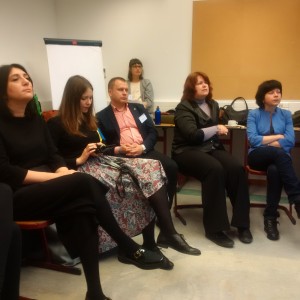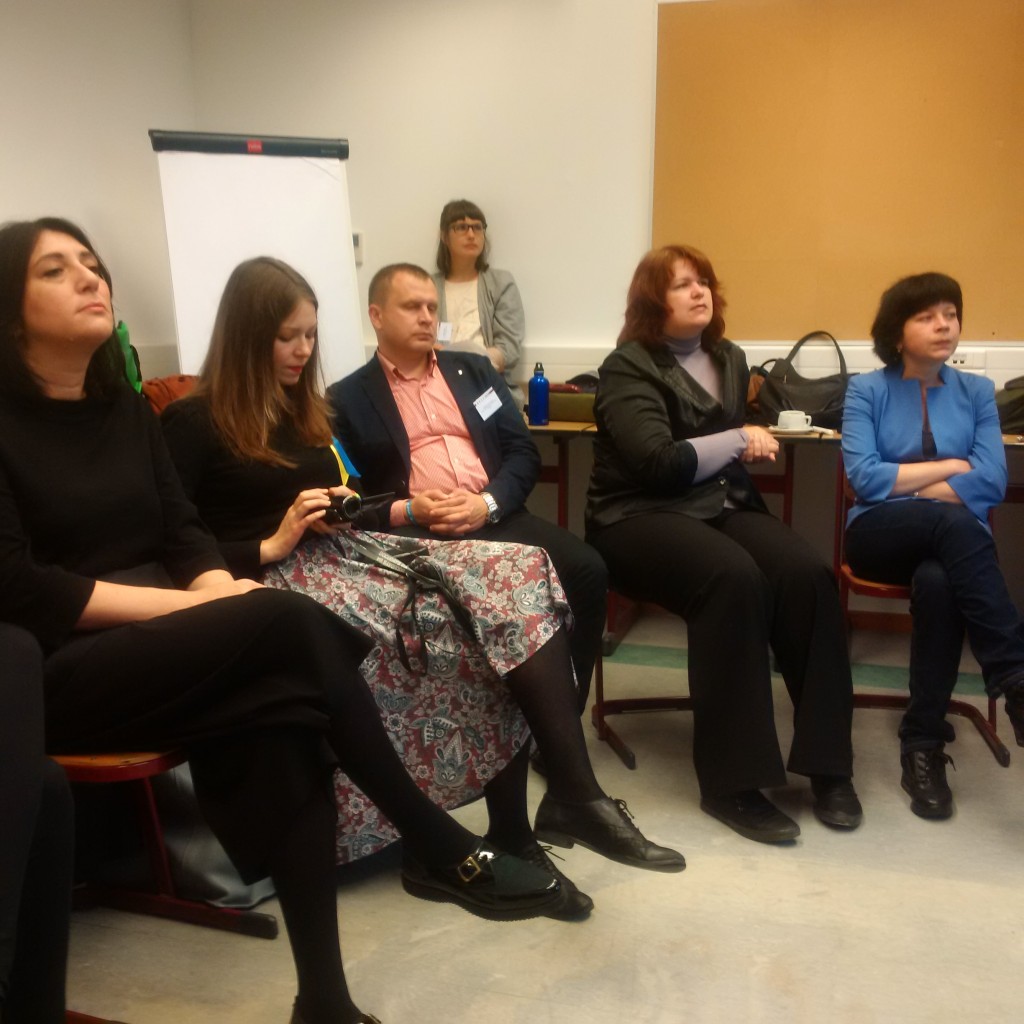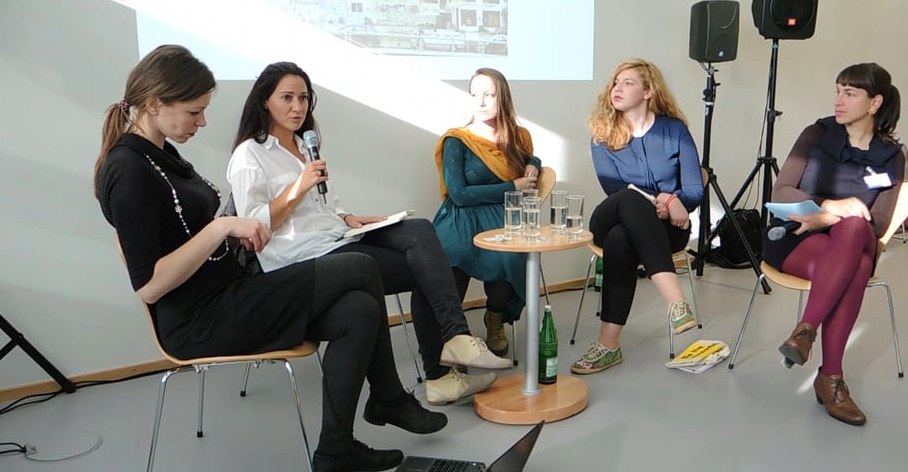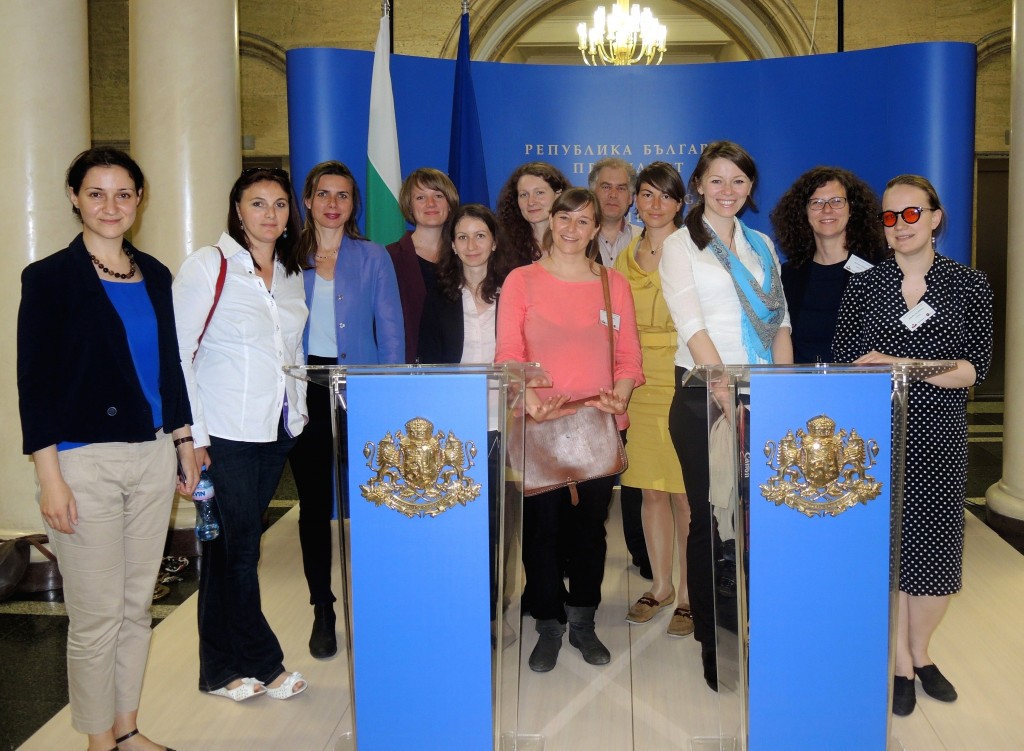Results from a Workshop at the 2015 NECE Conference in Thessaloniki, 22nd October 2015
Why we are asking this question
“Transition ends when we have disenchantment,” we learned in our first meeting in Sofia. But when transition ends due to disenchantment, it does not mean, that everything is ‘done’. Rather, people have become frustrated about the transition process, they do not believe in their possibility to bring about change. As activists, teachers, researchers in the wide field of civil society and citizenship education one of our main concerns is how to empower people. How to encourage them to be the change the want to see happen? In this brief workshop we presented best practice and learnings from our own work and asked participants to share their experience.
The workshop was held by Many Schulze (Perspektive³, Berlin), Olena Pravilo (Congress of Cultural Activists, Kiev) and Christine Wetzel (German-Russian-Exchange, Berlin). Documented on film by Dörte Grimm (Perspective³).
The workshops participants joined us from Georgia, Moldova, Ukraine, Armenia, Belarus, Azerbaijan, Croatia and Germany.
Olena’s Case on D riving Change: Establishing a Cultural Management in the community of Zaporizhzhya (Ukraine)
riving Change: Establishing a Cultural Management in the community of Zaporizhzhya (Ukraine)
It all started with the occupation of the Ukraine Ministry of Education. The idea was spread on Facebook by artists and cultural managers after the end of the Janukovich government. It was not to destroy anything symbolically, but actually to do better, and to run the ministry with a lot more passion and expertise.
The problems of Ukraine’s cultural administration were, according to Olena, lacking concepts for cultural development, overall bad administration of policies, and no openness towards other sectors as education or economy. The idea of self-made cultural policy spread to other cities, Assemblies of Culture were set up and registered as NGOs – as in the community of Zaporizhzhya.
Olena explained, what drove the activists to take this great challenge was not to accept excuses: “We in Ukraine can always look at other countries and find reasons why things can not be changed here: Because we have less money than Germany, because we are not so small like Estonia, and so on. But we said, we can do it. We just start, see what works elsewhere and try to do it here.”
Therefore, the activists in Zaporizhzhya invited experts from all over the Ukraine to share their experiences and best practice from other communities. There was no big funding for this event, everybody traveled on her or his own expanses, local activists all provided their bit to make the event happen. It was a kick-off for cultural self-management in the Zaporizhzhya. By now, the activities have resulted in the initiating of a cultural strategy for the community, and the developing of a cooperation with the Economic University. A book fair was established and diverse cultural projects created.
“We need examples, we need to repeat them, spread them, show others what works,” Olena stressed, and, as simple as crucial: “Ask people to do something! Encourage them, give them examples of what they can actually achieve. Do you have a telescope, do you know something about the space? Why don’t you show children the starts and the universe?”
Mandy’s Case on Driving Change: How young people looking for place to live accidentally opened a social space and investigated local history (Germany)
Mandy’s story of change had to starting points. One was a typical ‘lost place’, like you can find plenty of it all over the former communist countries in every community: empty town halls, factories, schools, hotels ect.
One the other side there were five young people looking for a place to live and work. They found an empty, run down public house in the town of Niederoderwitz to settle.
“The five had nothing in mind with community issues or civic empowerment,” says Mandy. “But From the moment they had started to work ob the house, they got confronted with locals who stopped by and asked to come in and have look. They became aware of the enormous meaning the house has for the people in the village.” For decades all festivities had been celebrated here; birth, birthdays, carnival, thanksgiving… With closure off the hotel the village had lost it’s social heart, the place were people would meet.
So, they opened the house for a first garden party – and 800 out of 1.500 villagers came. Consequently, the house was opened regular and became the new community center. The group of 5 people grew to 25. They were confronted with new issues of management; dealing with the administration, finding supporters and funding, investigating the local history. They invited chronologists and historians. They established themselves in the village, got children and had to deal with related issues, like Infrastructure for young families.
Essentially, the hotel hall was not just a place to celebrate. A public space like this is simply crucial for the development of a sense of community in the first place. Without a place to gather, community life is disintegrating, emptying and frustration growing that there is ‘nothing here anymore’. The five young people had realized the potential of that place. How it matters to people, that they perceived it as an open wound in their village – and they are willing to change something about it, to give it new sense. By accident, they, just seeking affordable housing, became community activists, bringing public space and local citizen-driven self-organization (back) to live.
Thus, in terms of the workshop question, the case shows three things: Firstly, start small and local, the ‘home’ is a place everyone can emotionally connect to – and this is crucial.
Secondly, the people can create a political awareness starting from concerns for issues that are considered to be not political at all, like housing, some questions asked on the past.
And finally – despite all praise to the possibilities of virtual communication – the necessity to provide a physical space, a laboratory and hub for encounters and those who are willing to be drivers of change.
see more of this case on Facebook: www.facebook.com/KretschamNiederoderwitzEv/
In 2013 a network was founded supporting initiatives like that in Niederoderwitz reclaiming the public space. They are analysing and providing knowledge and support on issues like: What are triggers for civic engagement?
What are the challanges for those who want to engage? How can they be supported? www.zukunft-oberlausitz.com
Open Discussion Results
We asked everyone to note down her and his answer to the workshop question and later share it with us. Here are insights the that were given by the participants from their experience:
- Do not work on a group, you want to do something for, but work with them. Listen and develop approaches with them, that build on their needs, ideas and capacity.
- Show people ‘the better live’ that is possible and provide them with examples how to get there.
- You need a common issue if you want to keep people on board. This seems obvious, but often it is not the case when you look closer.
- Education is an extremely powerful tool!
- Ask people questions that make them start thinking.
- Talk, talk, talk to people! Support encounters between different groups to share experience and examples, then develop programs to implement knowledge in practice.
- We need to make ourselves visible, we need public spaces to unfold, grow and spread ideas.
- Perform the best examples of your own, be the example, be the change – start local, then grow up the levels.
- Support the people, who are willing to do something; empower them, build their confidence, if possible provide financial support.
- Show them the consequences of their actions, show them what happens when the make changes – and what if not.
- Networking and team-building: Make people feel that they are not alone!
- You need to organize and structure the ideas, provide the ground to make ideas work
- Lower administration burden!
The workshop holders suggest, that the examples given by the participant apply to all kind of civic engagement in different circumstances. We further suggest, all the points given link into each other and form a ‘Circle of Motivation‘:
The chart point to motivation and incentive structures on different levels; the individual (1) (2), but also organizational (3) (6) and institutional (4, also including funding) level, that are all relevant for people to drive change processes – though one can partly make up for the other. Bottom up activity should ideally meet a top down structure that facilitates engagement, e.g. with funding, providing spaces for meeting, give access to key actors. But this are not opposites: The Ukraine example shows the attempt of changing this very environment for activity.
The six elements build on each other and are linked, but they are not solely linear: E.g., sure, it helps to talk about and spread your cause at every stage of the circle. And, obviously, listen to those you want to address with your activity before you start is always a good idea! As it was stressed by a participant from Georgia early in the discussion, our attitude towards those who we want to work with is important. We should be facilitator, not the instructor who always knows better. For there is nothing less encouraging if you do not get the chance to follow your own ideas.
And finally: Do never forget about the social experience of engagement! Whatever you do; provide space for getting together also with agenda, celebrate results, tell others, honor activity and – say thanks.
Circle of Motivation

Thank you to all of you who joined this workshop and shared their experience!
by Christine Wetzel
see the workshop video and read more about what we did at the conference http://www.transition-dialogue.org/workshop-at-the-2015-nece-conference-in-thessaloniki-22nd-october




